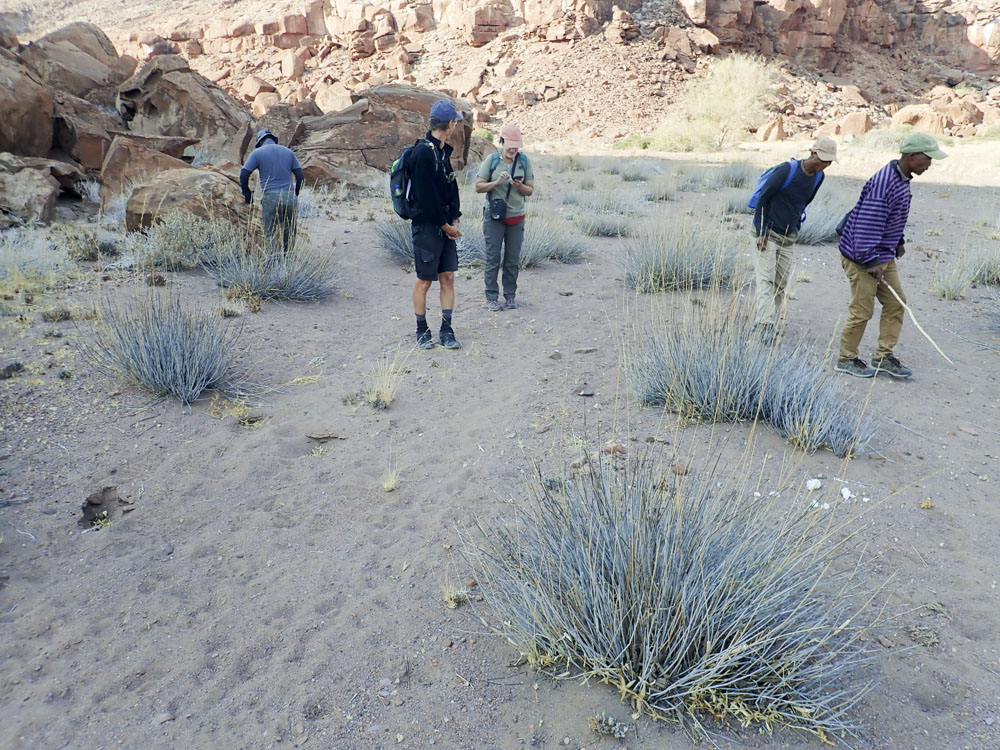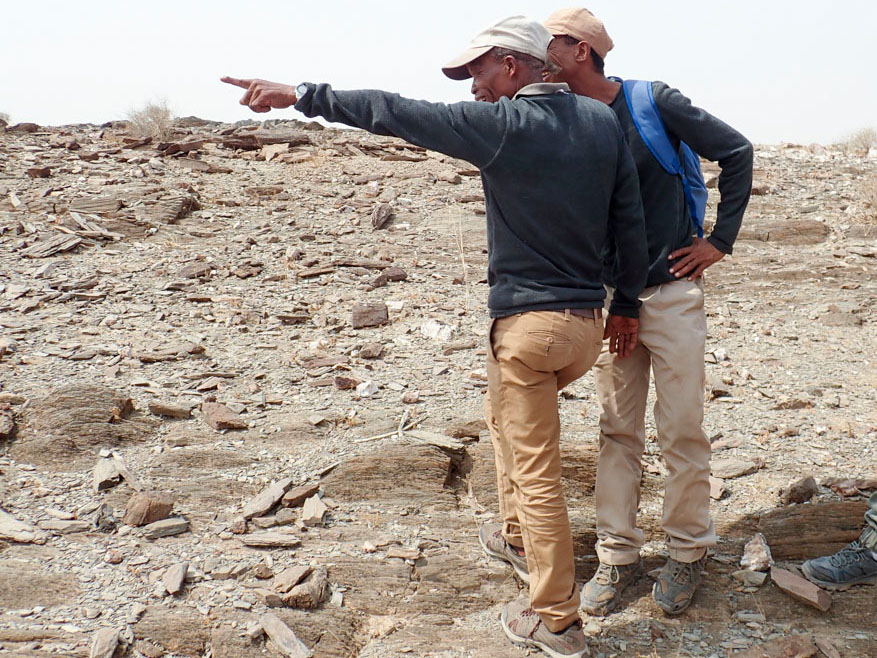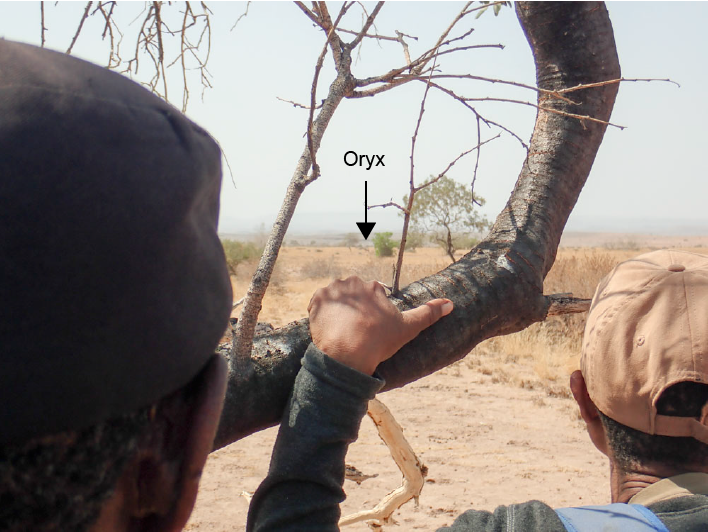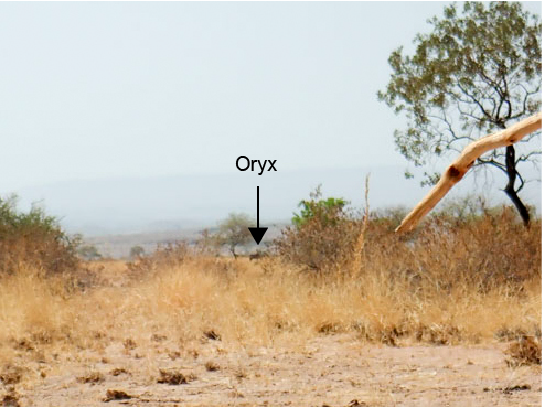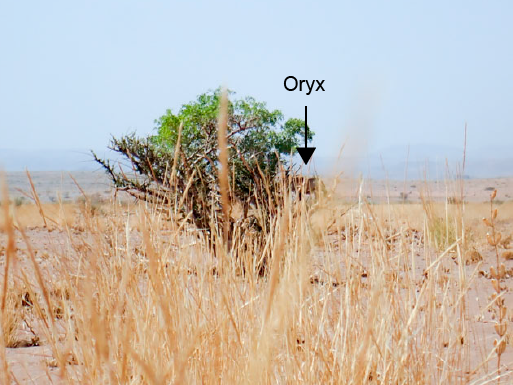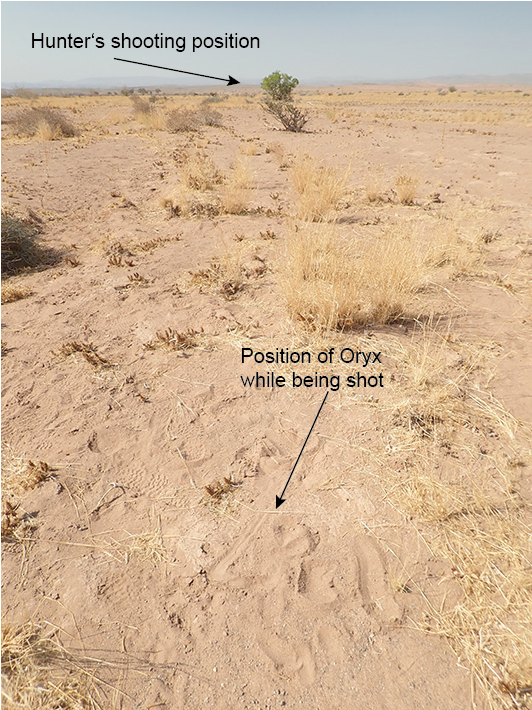Fieldwork
Methods
Data collection relies on thorough, "thick", documentation of the movement and decision patterns of traditional hunters during daily hunting bouts in the → Study area. Thanks to the minimization of technical devices, the recording of GPS position to the second and the physical effort of the participants can be recorded using Smartwatches, which do not interfere with the hunters' movements. Physical aspects of traditional hunting is only one aspect of the documentary work. Another aspect is the documentation of hunting decisions and behaviour. In general, traditional hunting in San communities is a team's work. Among the Ju/hoan San today, a hunting group usually consists of small groups of two to four hunters. Techniques of finding and approaching game, wayfinding, orientation, and dealing with wind direction, landcover, vegetation, etc. are discussed and managed by the team, which gives a scientist the opportunity to tap verbal and non-verbal (e.g. hand-gestures, throwing sand for wind direction check etc.) communication. These decisions are documented using foto, audio, and video recording, as well as using a digital user-input form (open source Cybertracker software[1][2][3]) installed on ruggedized outdoor smartphones. Also, fresh tracks of large animals as well as game being spotted and hunted are noted digitally in Cybertracker to get an overview of potential hunting fauna being present in the area.
To some degree, walking speed and wayfinding rely on physical landscape characteristics. Some of these aspects can be accessed from remote imagery (e.g. satellite images), i.e. whether the hunters choose to walk in vegetated riverbeds to better hide from the surrounding plains. Other factors must be recorded on site. For instance, softness or slipperyness of the ground can only be perceived in the field and depend on the landcover's grain size. While walking through fine sand can be slower or more exhausting than walking on hard gravel, walking over rocks on a slope may become slippery and dangerous, thus slowing down walking speed as well. Hopping from one boulder to another up or down a slope or a small riverbed is again different from the previous conditions, affecting walking direction and speed. Therefore, empirical data about landcover are noted as well – whenever it changes – using Cybertracker software.
Seasonality
Due to the arid to hyperarid conditions in the Namib Desert, where the → study area is located, seasonality is not too much expressed in terms of change in vegetation. But hunting behaviour may deviate in different seasons depending on the presence of game and water. Therefore, fieldwork is designed to take place in both, the dry season (→ Data collection dry season 2019) and the rain season (→ Data collection rain season 2020).
Exemplary course of a hunting day
Preparation
When devices were in synced in time (→ Technical equipment), participants were equipped with ECG belts and smartwatches. When every participant was fully equipped, smartwatches were set to “work-out mode”, thus enabling continuous per-second GPS and heart-rate measurement. While the smartwatches were acquiring GPS connectivity, location services were started also on the smartphones to run CyberTracker. When the smartphones properly acquired a GPS signal, CyberTracker was started and participants were ready to go.
Searching game
Hunting is particularly successful when several strategies are pursued simultaneously. The search and pursuit of fresh tracks is one strategy. Another is the search by sight. If an area is slightly richer in vegetation, animals in hot regions like to stand alone or in small groups in the shade of trees and bushes. Hunters are thus more successful if they search the distance for game and the nearer surroundings for fresh tracks at the same time. A regular check of the wind direction is necessary so that animals in walkind direction do not smell the hunters before the hunters can see them. In addition, in areas with distinctive topography or vegetation, orientation also plays an important role, as one must be able to find the way home.
One person can hardly manage all this alone. Therefore the Ju/hoan San from the Nyae Nyae region go hunting in small groups of 2 to 4 persons. During the search for game the group walks behind each other in short distances. This allows several people to search the distance for animals and at the same time the nearer surroundings for fresh tracks.
If they stay close behind each other and the game in front of them notices the hunters first, the animal sees only one person and not several. If the group moves slowly and stops or crouches in time, the animal may not notice them at all. If the first person is recognized as a human being and keeps an eye on him, the hunters behind can crouch and slowly sneak out of the row to attack the animal from the side.
When sneaking up, verbal communication is not possible because the hunters would quickly betray themselves as humans. Therefore, very specific gestures and whistling signals are used. So every animal has its own hand signal.
After leaving the camp in the morning, the first hunting activity was to search for game. It was accomplished in a double strategy: searching by sight and simultaneously looking for fresh tracks in the vicinity. In the Doro !nawas mountains vegetation is so sparse that visibility is often limited only by topographic features. Not only human hunters profit from this open landscape, but also the potential hunting game, which can spot potential aggressors over great distances. Vegetation therefore played a double role in hunting strategies. On the one hand, it was impossible to approach game at shooting distances in places without vegetation. On the other hand, regions richer in vegetation proved to be the usual grazing areas of antelopes, the main hunting game of the Ju/hoasi trackers. Bushes and medium sized trees usually occur in the study area along the dry river beds that drain the area.
In case a vegetation-rich place was a wide and and flat area, it was searched all day long. In case a dry river bed was long and narrow, shifting to another dry river bed was occasionally practiced by crossing intermediate ridges. This way the trackers managed not to move too far away from camp. But since the study region was foreign to the trackers, the crossing of intermediate ridges involved a higher risk of temporarily losing orientation.
Picture gallery: Searching game
Approaching and shooting game
Either when game was tracked up to visual contact or sighted by chance — the latter of which seems to have occurred more often — an immediate shift in the hunting strategy took place. Immediate stopping, often together with crouching down, increased the probability of not being seen by the game. If the game had not noticed our presence, one or two trackers separated from the group and approached it, either directly, or on larger detours, depending on wind direction. The rest of the group hid in the meantime and waited for the hunting party to come back.
Research objectives rely on mobility patterns and not on hunting success. Successfully shooting an animal therefore had rather symbolic character and served to corroborate the relation to real hunting situations. Hunting success was documented in the following way. While approaching game the hunting party had to estimated when proximity to the animal was sufficient to launch an arrow. “Shooting the animal” then was accomplished with a dustproof, robust compact digital GPS-camera (Olympus TG-5, Olympus TG-1), by taking a photograph, by which probability of success could be estimated subsequently, and a GPS position of the shooting spot. In cases when the hunt could have been successful, the hunting party went to the spot where the animal had been standing and took another photograph, by which the track of the animal was taken, again along with a GPS position.
Picture gallery: approaching game and successful hunts
Termination/back to camp
As the trackers claimed, in real hunting situations an animal injured by a poisoned arrow would run away, separate from the group and die within some minutes or several days, depending on species (body size) and the body part being hit. Relying on the effect of the arrow poison, an affected animal is not pursued any further, but left in peace in order to prevent it from moving unnecessarily far away while escaping. Therefore, in real hunting situations, the trackers return one or two days later to the place where an animal was shot in order to follow its track to the place where it eventually died. In the virtual hunts this hunting strategy was neglected since the animals ran away but were not poisoned. Therefore, whenever an animal was successfully “shot” with the camera, the hunting bout was terminated, and the way home was initiated. In order to raise the motivation of the hunters to invest realistic efforts in hunting a bonus of 10 kg of meat per successful shot (i.e. photo from nearby) was warranted.
In case no potential game was seen during the whole day, or hunting was unsucessful, the hunters initiated the way back in due course. Often the direction was changed only slightly, so that the hunters went back to the camp in a large bend. But it also happened that the end of the hunting day was announced and the way back was initiated directly.
Picture gallery: way home
Data types
Despite the large number of different documentation tools (→ Technial equipment), the number of data formats is comparatively small. This is due to the fact that the open source “FIT” file format has gained acceptance across smartwatch brands. Worth mentioning in this context also is Cybertracker, which produces an SQL database, stored as an Microsoft Access file. Importantly, installing the proprietary database software Microsoft Access is no requirement to analyse the resulting data, since the open-source software Cybertracker allows opening, filtering, post-processing (modification) and exporting of the collected data. Supported export file types include open accessible comma separated text files for table entries and ESRI Shapefile for tracks and Waypoints:
| Device | Format |
|---|---|
| Smartwatch | FIT |
| Kameras, GoPro | RAW, JPG |
| Cybertracker | SQL,CSV,SHP |
Next: Technical equipment
References
-
Liebenberg, L., Steventon, L., Benadie, K., Minye, J., 1999. Rhino tracking with the CyberTracker field computer. Pachyderm 27, 59–61.
-
Ansell, S., Koenig, J., 2011. CyberTracker: An integral management tool used by rangers in the Djelk Indigenous Protected Area, central Arnhem Land, Australia. Ecological Management & Restoration 12, 13–25. DOI: 10.1111/j.1442-8903.2011.00575.x
-
Cross, M., Page, T. 2020. Indigenous trackers are teaching scientists about wildlife. CNN
